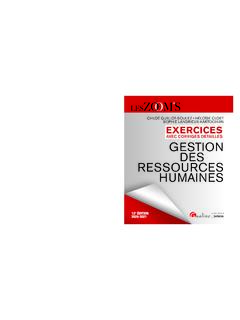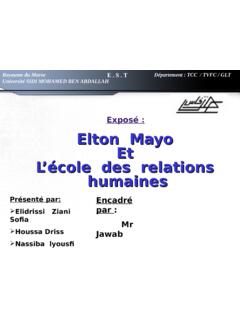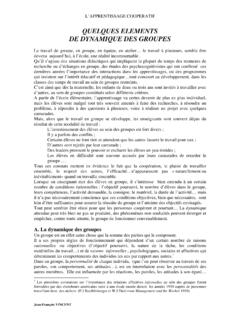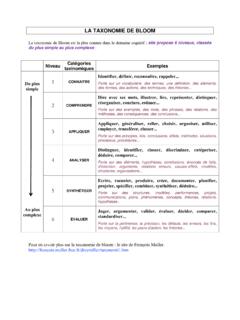Transcription of Three Fundamental Bonds and Five Constant Virtues
1 2009 by Berkshire Publishing Group LLC2252 Comprehensive index starts in volume 5, page Three Fundamental Bonds and the Five Constant Virtues are separate Confucian terms for the most important human relations and social Virtues . In early Confucianism, one who perfectly fulfilled these relationships and man-ifested these Virtues was the highest form of human a sage. The neo- Confucians combined these two terms into a single cosmological prin-ciple that stood for human social expression Three Fundamental Bonds and Five Constant Virtues sums up a Confucian doctrine that was designed to guide people s behavior and aspirations in traditional China. The Three Fundamental Bonds deal with traditional society s most Fundamental social relationships: father and son, lord and retainer, and husband and wife.
2 As essential relationships, these Three serve as shorthand for all human relationships. The Five Constant Virtues mean the Confucian Virtues of benev-olence (ren ), righteousness (yi ), propriety (li ), wisdom (zhi ), and trustworthiness (xin ). As with the Fundamental Bonds , these five Virtues are the most significant ones and thus serve as shorthand for all the Con f uc ia n v i r t ues . I n ot her word s, t he Th ree Fu nd a ment a l Bonds designate the social relationships that are essential for structuring human social life, while the Five Constant Virtues are the values needed to live a moral late imperial neo- Confucians the Three Fun-damental Bonds and Five Constant Virtues (sangang wuchang ), or t he shor ter Bond s a nd Consta nt s (gangchang), was the heart of Confucianism.
3 Zhu Xi (1130 1200), the great synthesizer of Neo- Confucian thought, criticized the teachings of Buddhism and Dao-ism in the following manner:[It] is unnecessary to analyze them to understand that they both abandon the Three [ Fundamental Bonds ] and Five Constant Virtues . Just this one [omission] earns them a reputation for commit-ting a grave crime. It is unnecessary to say any-thing else about other words, if a teaching did not promote the Fun-damental Bonds and Constant Virtues , then not only was it of no account, but, even worse, it was guilty of promot-ing disorder. Zhu Xi believed that humans could become sages by perfecting these Three relationships and realiz-ing these five Virtues . Interestingly though, in terms of China s long history, these concepts of the Three Funda-menta l Bond s a nd t he Five Consta nt V i r t ues d id not have an ancient pedigree: they were creations and expressions of the unified Han empire (206 bce 2 2 0 ce).
4 Hence, one could cynically argue that the guides and Virtues were Confucianism in the service of the state. The full four- character term sangang wuchang was not commonly used until the tenth century Fundamental BondsSearching the Confucian classics for a reference to the Three Fundamental Bonds , one encounters Confucius s Three Fundamental Bonds and Five Constant VirtuesS ng ng W ch ng Three and Five A ntis CampaignsThree Fundamental Bonds and Five Constant Virtues n S ng ng W ch ng n 2253 2009 by Berkshire Publishing Group LLCconditions for a well- ordered society: Let the lord be lordly, the retainer loyal, the father fatherly, and the son sonly (Analects , L ny ). Here though, Con-fucius presents only two relationships: lord and retainer, and father and son.
5 In the Mencius (M ngz ) one finds five rather than Three principal human relationships (renlun ); moreover, the text stresses their recipro-cal basis: Father and son have love [for each other]; lord and retainer have obligations [to each other]; husband and wife have distinct [spheres]; senior and junior have precedence; a nd f r iend s have fa it h [i n each ot her] (Men-cius ). A lthough clearly a strong sense of hierarchy pervades each set of relationships, both Confucius and Mencius underscore that everyone, whether a superior or an inferior, has obligations to properly fulfill his or her role. As the Confucian scholar Hs Dau- lin has pointed out, the first text that more overtly promotes what would become the Three Fundamental Bonds is one of the later chapters of the Legalist text written by Han Fei Zi.
6 The chapter, which probably dates from the beginning of the unified Han empire, states: A retainer serves his lord; a son serves his father; a wife serves her husband. If these Three principles are followed, then all- under-Heaven is wel l- gover ned; i f t hese t h ree pr i nc iples a re bet rayed, t hen all- under-Heaven is in chaos (Chapter 51). W hat is strik-ing is that no mention is made of mutual first person to label these relationships was Dong Zhongshu (197 104 bce), the great Han dynasty Confucian philosopher and statesman. Dong called them the Three Cardinal Guides or Bonds (sangang). For him, these relationships are not social constructions; instead, they are natural expressions of the cosmological princi-ples of yin and yang. He tells us in The History of the Han (Han shu ):The lord is yang , the retainer is yin ; t he fat her is yang , t he son is yin; the husband is yang , the wife is yin.
7 The way of yin cannot proceed any where on its own.. Therefore, the retainer depends on his lord to gain merit; the son depends on his fa-ther; the wife on her husband, yin on yang , and t he E a r t h on Heaven .. The Th ree [Fu nda ment a l Bond s] of t he k i ng ly way ca n be soug ht i n Heaven . (Chapter 53)Since for Dong yang is superior to yin, lords are su-perior to their retainers, fathers to their sons, and the husband to his wife. In other words, Dong accepts Han Fei Zi s formulation of these relationships as entirely ver-tical and one sided. That Dong was living in a centralized empire and serving a powerful monarch undoubtedly helps explain his most extensive formulation of the concept behind the Three Fundamental Bonds is found in Baihutong ( Comprehensive Discussions in the White Tiger Hall ) by Ban Gu ( 3 2 9 2 ce).
8 The book devotes an entire chapter to a discussion of this notion. Interest-ingly though, here the Three Fundamental Bonds are not matched up with the Five Constant Virtues but rather with the Six Rules (Liuji ), which are relations with one s paternal uncles, brothers, clansmen, maternal un-cles, teachers, a nd f r iend s. The Th ree Fu nda ment a l Bond s The Three - year-old Prince Bu Yi, throne name Xuantong, on the right. On the left is his father, Prince Zhun, the Regent, holding a younger brother, 1909. The Confucian influence of the Three Cardinal rules applied even to the highest levels of Chinese society. Library of Encyclopedia of China2254 2009 by Berkshire Publishing Group LLC and Six Rules thereby incorporate all the most impor-tant social relationships that constitute society.
9 Without them society falls apart. This same book tells us: In past times, the Three Fundamental Bonds and the Six Rules did not yet exist; as a result, people only knew the identity of their mother, not their father (Chapter 2). That is to say, without these Fundamental relationships, civilized social order cannot Five Constant VirtuesEven though the Five Constant Virtues (benevolence, righteousness, propriety, wisdom, and trustworthiness) were a r t ic u lated a s such on ly i n t he Ha n dy na st y, t he idea of five interrelated Virtues appears earlier. The fourth- century bce Confucian text known as the Wuxing ( Five Types of Action ) argues that there are five types of favorable behavior: benevolence, righteousness, pro-priety, wisdom, and sagacity (sheng ). The person who harmonizes and enacts four of these actions, is good.
10 The person who rea l i zes a l l fi ve of t hese ac t ions is a sage (shen-gren ), in accord with heaven. Here, four of the Five Constant Virtues are articulated, and sagacity substitutes for trustworthiness. The Mencius sets forth four of Five Constant Virtues , leaving out sagacity. In an argument about whether human nature is intrinsically good, Men-cius notes: Benevolence, righteousness, propriety, and wisdom are not welded onto me from the outside. They a re t hat wh ich I have a lway s had (Mencius 6A .6). I n ot her words, these four Virtues are inherent in all again, Dong Zhongshu, the Confucian states-man and philosopher, was the first person to unambigu-ously use the term wuchang to designate the Five Constant Virtues . He relates:Benevolence, righteousness, propriety, wisdom, and trustworthiness , the Way of the Five Constant Virtues should be that which the k i ng c u lt ivates.





